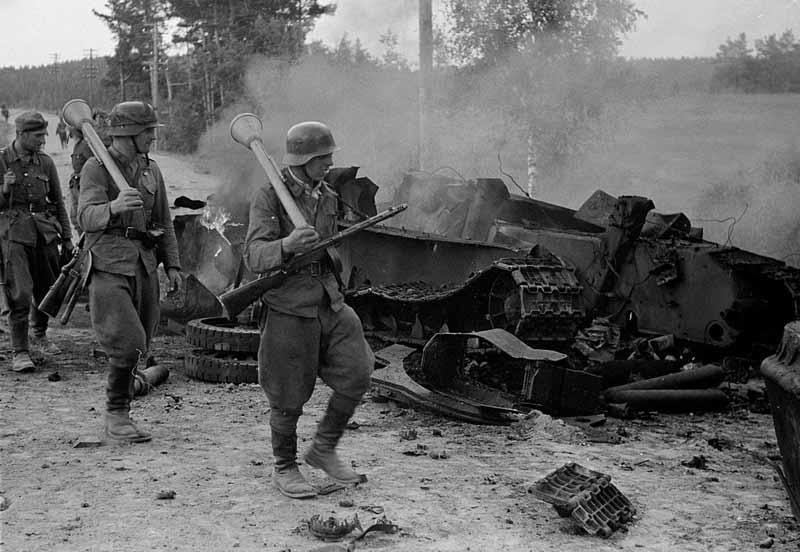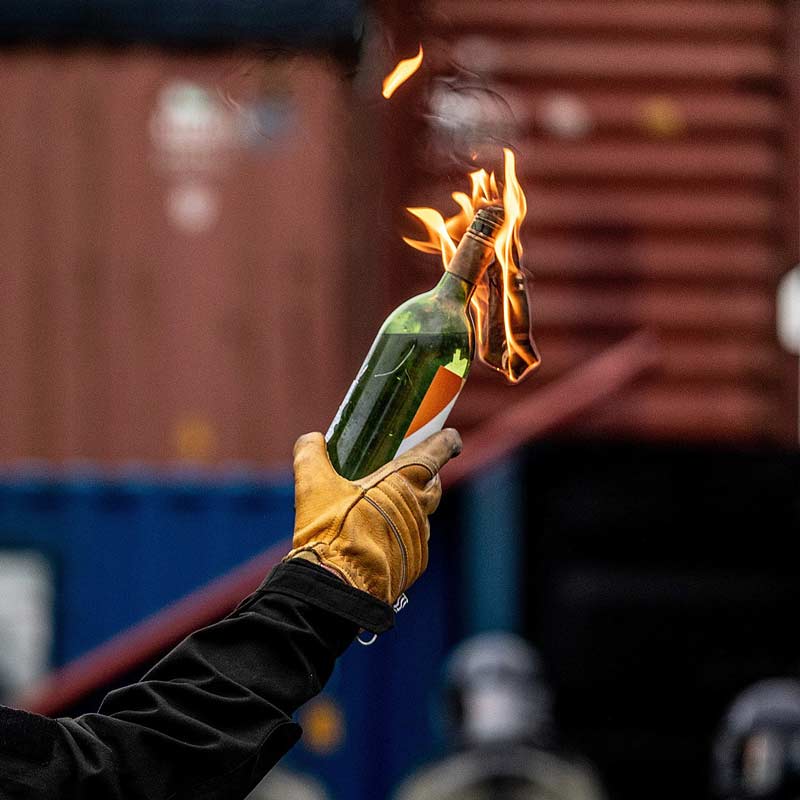
When it comes to weapons and equipment to repel a Russian invasion, the fighting forces of Ukraine aren’t particularly picky. They can’t afford to be. They have employed old and new; low-tech and high-; Soviet, American, Austrian, Israeli—whatever they can get their hands on. Yes, even Canadian.
There are Panzerfausts—the German descendants of a favourite Wehrmacht anti-tank weapon of the Second World War—alongside Soviet-era RPG-7s and Lockheed Martin’s sophisticated FGM-148 Javelins, the latter going at $340,000 a shot.
Generations of tanks prowl the Ukrainian countryside, from the venerable Soviet T-55 to the German Leopard and American M1A1 Abrams. The skies are populated by a menagerie of helicopters: Soviet-era Mils; British Sea Kings; French Airbuses.
Names like Fiat, Volkswagen, Mitsubishi, Toyota, Ford, Jeep, Land Rover and Peugeot make their way through the mud and the rubble, transporting personnel and materiel. There’s even a Tarpan Honker, a handsome all-purpose vehicle from Poland.
Much of the Russian equipment—and there’s a lot of it—is captured; some is left over from Ukraine’s 72-year domination by the Soviet Union, first as a satellite state, then as a Soviet republic.
Throughout what is at this writing 437 days since unfriendly Russian forces crossed into their neighbour’s territory, the defenders of Ukraine have sustained an inspiring defence based largely in innovation, adaptability, resourcefulness and, in no small measure, guts and determination.
In turning what Vladimir Putin touted as a three-day “special operation” into a costly 15-month war that has gutted some elements of the Russian military, the Ukrainians have demonstrated the value of mind over matter—of sheer will, thoughtful planning and relentless resistance in a David-versus-Goliath fight for survival.

Russian troops had no sooner mobilized in February 2022 than Ukraine’s defence ministry was urging civilians to produce Molotov cocktails. The bottled gasoline bombs were first used against Soviet troops by Franco’s Nationalists during the Spanish Civil War and later popularized by Finnish defenders against—you guessed it—Soviet invaders.
A Ukrainian TV channel broadcast a recipe using Styrofoam as a thickening agent to help stick the burning liquid to vehicles and other targets. Ukrainian civilians took up the cause, turning a derelict industrial complex into a Molotov factory.
In the western Ukrainian city of Lviv, the Pravda Brewery stopped making craft beer and instead turned its empty bottles into Molotov cocktails, labelling them Putin Huilo—“Putin is a dickhead”—and sending them to Ukrainian hot spots.
The technology progressed. In basements and family rooms throughout the country, gadget geeks began fiddling with hobby copters, converting them into deadly reconnaissance and attack drones. Two steps ahead of the Russians at the time, such drones are credited with helping turn back Putin’s initial assault on Kyiv.
Even before the war began, students, academics and electronics hobbyists were using homemade drones and motion-sensing cameras to monitor the Russian military buildup along Ukraine’s border.
Indeed, the Ukrainian war machine has been guided by crowdsourced intelligence from across the nation, much as civilian volunteers in Britain phoned in early warnings of impending German air raids.
These days, the information flow is broader, more precise and more efficient than it was 83 years ago.
Ukraine’s Ministry of Digital Transformation developed the eVorog (eEnemy) chatbot in March 2022, just weeks after Russia invaded. A smartphone-based reporting app, it is believed to be the first government-developed technology of its kind.

The app had received more than 450,000 reports by December 2022.
Using the encrypted messaging platform Telegram, the chatbot asks users what they saw, where they saw it and when. Another government app, Diia, checks submitters’ identities and the phone’s GPS confirms the location.
“Evaluating the quality of the information supplied through eVorog, by matching it with other sources, is crucial,” notes The Economist. “It would be wasteful to attack a site from which the enemy had already departed, and disastrous to strike one occupied by civilians.”
The app had received more than 450,000 reports by December 2022.
Civilians in unoccupied parts of Ukraine use eVorog to report unexploded bombs and other munitions. Another app, ePPO, enables users to record the flights of aircraft, missiles and drones.
High and fast-moving ballistic missiles cannot be easily tracked by civilians. But the Iranian-made Shahed-136, an armed drone used by the Russians to attack Ukrainian infrastructure, cruises slowly at low altitude and is often spotted.
Information submitted through ePPO helps the Ukraine military destroy the drones. It can also alert teams manning anti-missile weapons.
The Economist reports that civilian intelligence has led to strikes on Russian bases and barracks in occupied territory. In September, residents of the city of Kherson, then under Russian control, used eVorog to report a warehouse where Russian military vehicles were stored. The building was destroyed in a strike the next day.
Those who submit information via eVorog from Russian-occupied areas are at particular risk, and the app advises users to delete any evidence they have uploaded. The laws of war do not protect civilians who play an active role in hostilities, including those who pass along tactical information. Thus, the app’s security is paramount to their very lives.
With the onset of war, consumer software developers in Ukraine pivoted and began producing or adapting apps to do such diverse war-related tasks as organizing anti-Kremlin protests, documenting war crimes, co-ordinating supply and, in the case of Air Alert—at four million downloads the country’s most-downloaded app—warning citizens of incoming attacks from the air.
“Yesterday, some soldiers…told us this app had saved their lives,” Valentine Hrytsenko, marketing chief of Ajax Systems, the Ukrainian security-systems firm that co-developed the air-raid warning app, told The Washington Post last year. “We feel very proud…to help the country to fight.”
Ukraine had a thriving tech sector before February 2022.
“In peacetime, the programmers of Ukraine’s tech scene crafted the consumer software that powered homegrown start-ups and some of Silicon Valley’s biggest names,” wrote the Post’s Drew Harwell.
“Now, they build apps of war—an unprecedented digital infrastructure designed for both front-line combat and the realities of life under siege.”
Ukrainians use apps to find evacuation routes and contribute to cyberattacks against the Russian military. There’s even an app to report Russian troop movements to Ukrainian intelligence. It collects tens of thousands of reports daily.
Meanwhile, Ukrainians have used social media to counter propaganda in Russia, rally spirits at home and mobilize antiwar sentiment worldwide.
“The developers say Ukraine was primed for this kind of resistance,” wrote Harwell. “Boosted by project-outsourcing budgets from the West, the country’s tech sector has become a digital juggernaut, with thousands working for homegrown start-ups and American tech giants including Google, Oracle, Snap and Amazon’s Ring.”
In contrast to Russia, where independent media has been squashed, dissenting voices arrested and its internet clogged with propaganda and conspiracy theories, the Ukrainian government has welcomed what Harwell describes as “this freewheeling style of technical innovation.”
Harwell describes some of the app’s most prominent features as “unmistakably militaristic.”
Ukraine’s Ministry of Digital Transformation launched the Diia (action) app in March 2022. It was a kind of digital driver’s licence that included links to public services such as coronavirus-vaccination certificates and construction permits.
The app evolved as the fighting escalated, from a stodgy public-service network into a full-scale companion for Ukrainians at war. Soon ranked among the country’s top three most-downloaded apps, it grew to include remote-job listings for out-of-work Ukrainians, a portal of cash payouts for citizens fleeing from combat, even classes for children stranded away from school.
But Harwell describes some of the app’s most prominent features as “unmistakably militaristic.” Ordinary Ukrainians can now use Diia to submit location-tagged photos and videos of Russian military sightings, as well as tips on “suspicious” people who might be invaders or saboteurs.
The data are aggregated onto a map visible to Ukrainian intelligence officials working on defence and counterstrikes.
Ministry officials have even adapted Diia’s facial recognition technology to scan and identify the faces of dead Russian soldiers. Ukrainian officials say it has enabled them to contact relatives of the dead back in Russia and help refute Kremlin claims that only a small number of its soldiers have died.
They have also developed systems to mass-dial Russian phone numbers and share the war’s grisly truths in attempts to foster the spread of antiwar dissent.
“We have all changed,” Ukraine’s minister of digital transformation, Mykhailo Fedorov, said in a March 2022 Instagram post. “We started doing things we couldn’t even imagine a month ago.”
Advertisement












